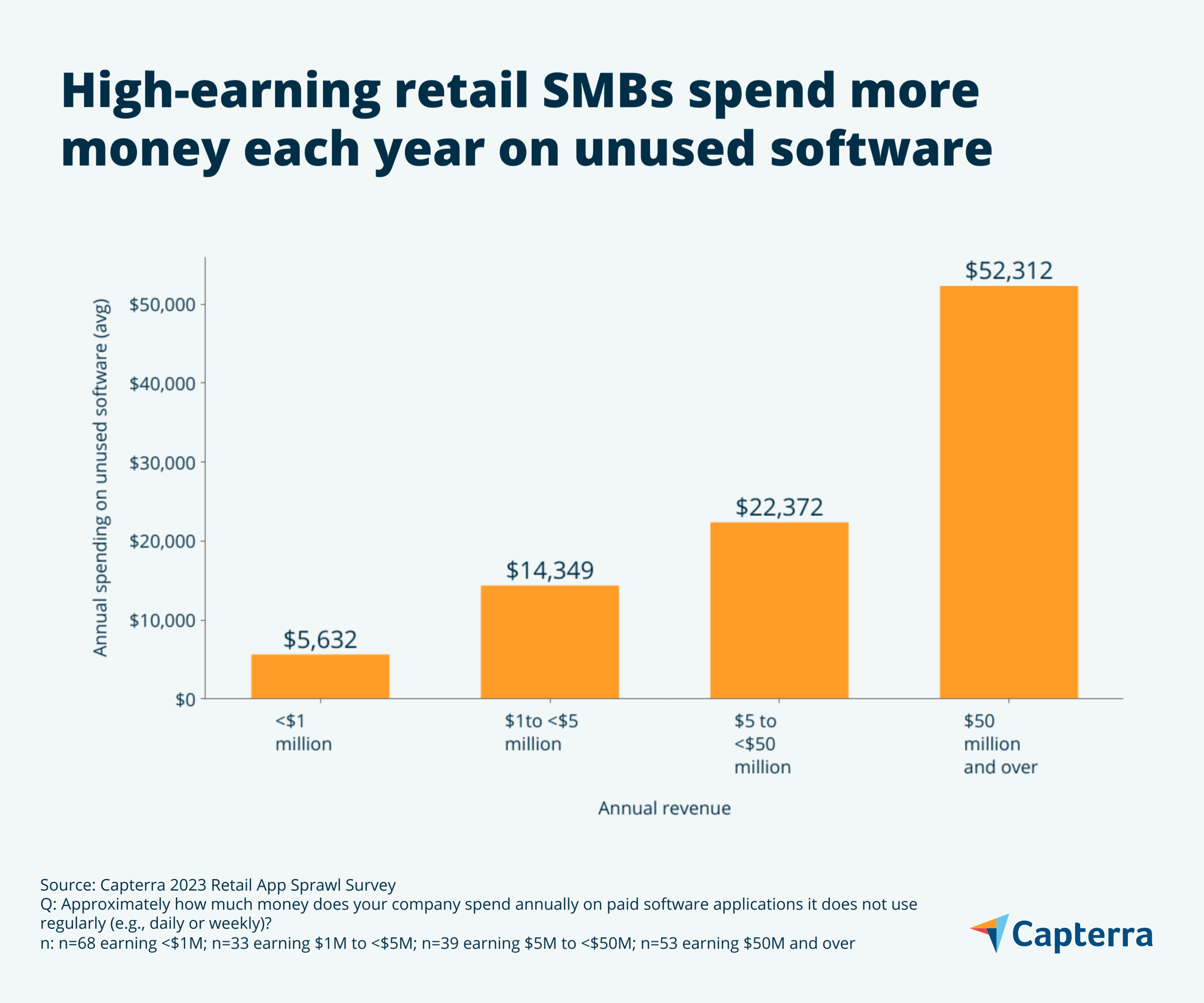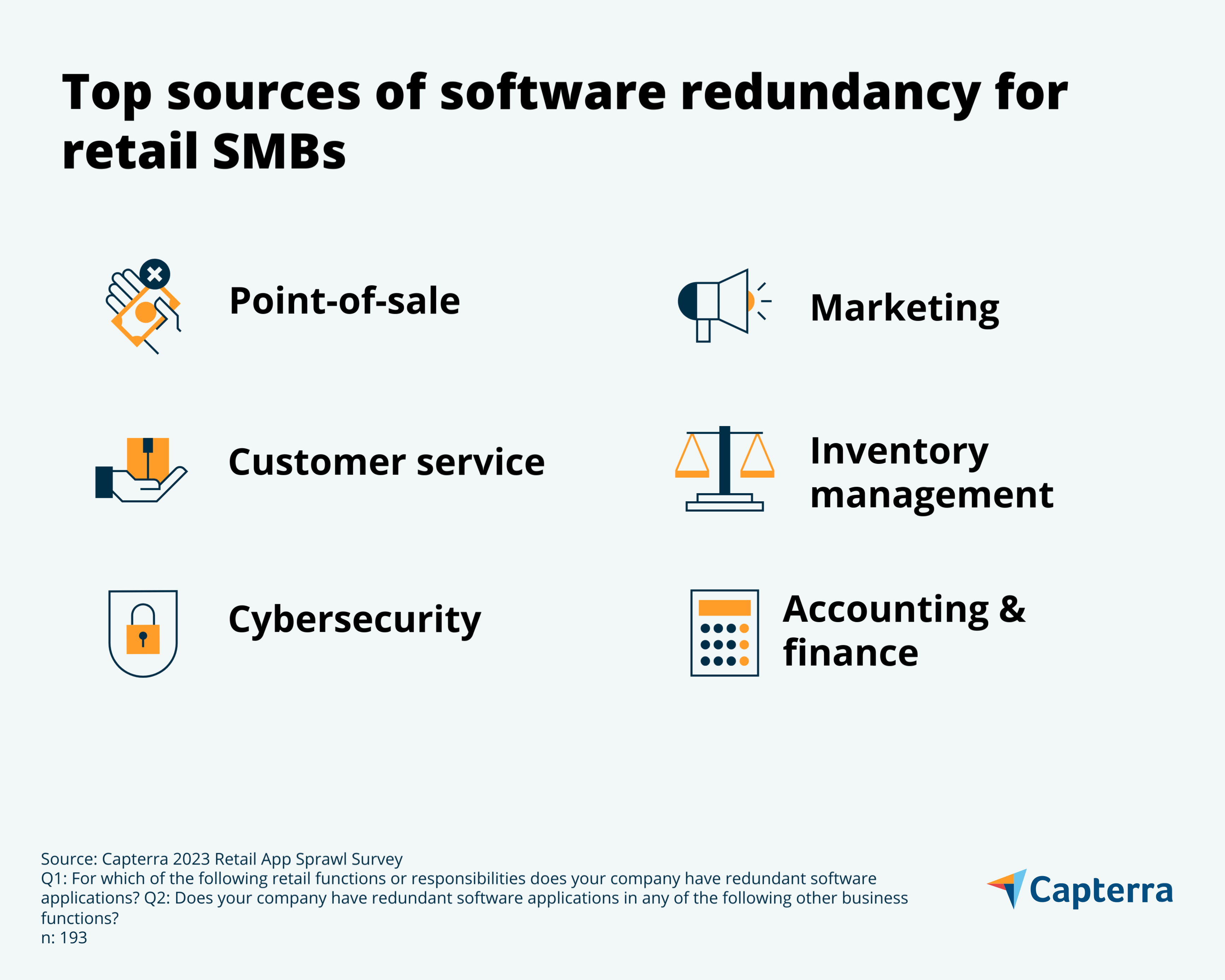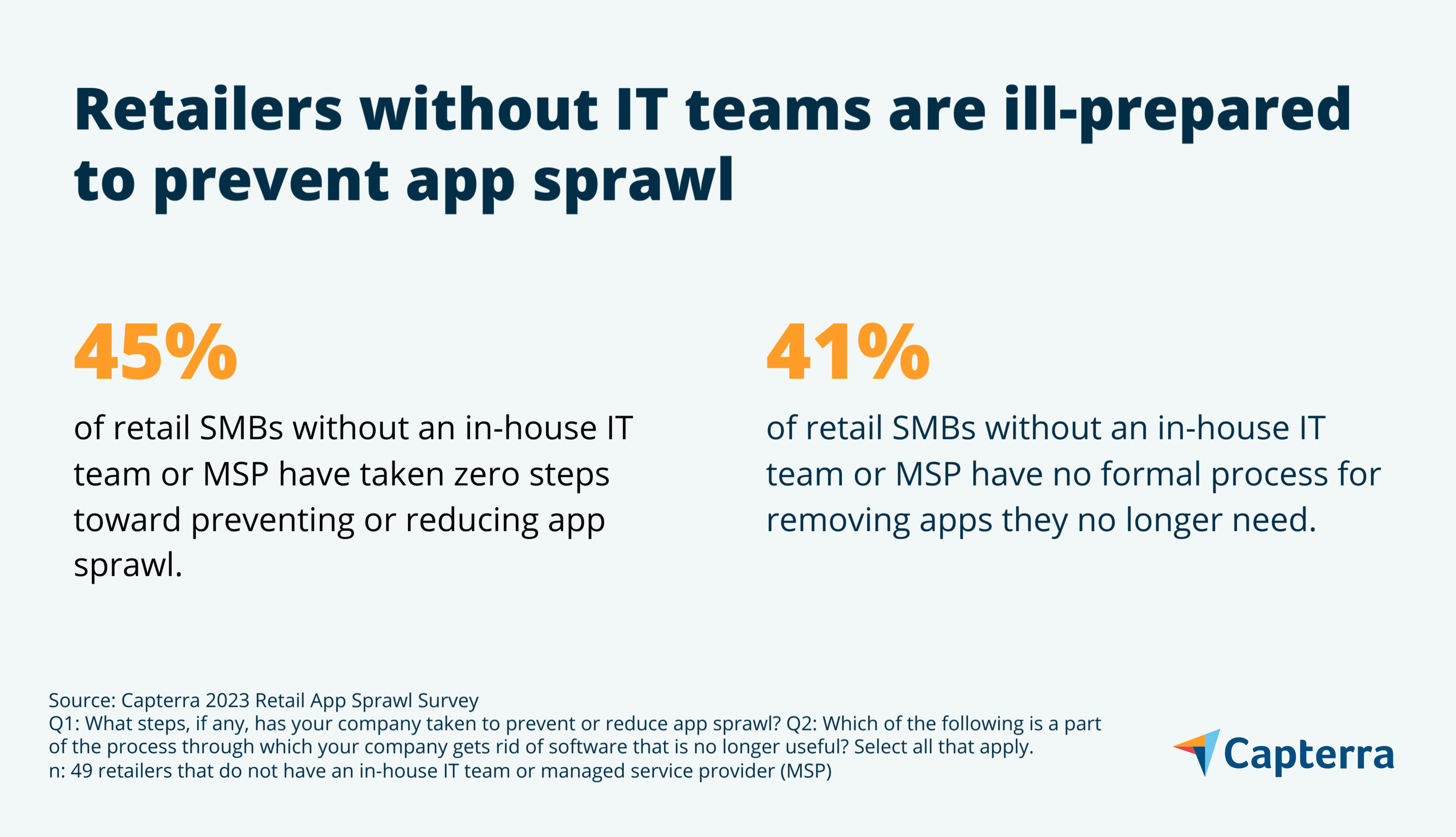Too many unused apps are draining time and money from small retailers.
The struggle to contain an overflowing tech stack is usually framed as an enterprise problem, with massive budgets and thousands of employees driving a company’s software subscriptions through the roof. But new Capterra research indicates that app sprawl is pervasive among small to midsize businesses (SMBs), too.
According to Capterra’s 2023 App Sprawl in Retail survey*, 55% of small to midsize retailers are currently impacted by app sprawl, and the severity is strongly associated with higher annual revenue. App sprawl can be a serious drain on budgets, productivity, and cybersecurity. And as revenue climbs, so do the challenges to overcoming app sprawl, underscoring the need for every retail leader to develop a prevention plan.
If you’ve never heard of app sprawl, or you think your company might already be impacted by it, we’ll fill you in on what to do about it. We'll give you insights from hundreds of retail SMBs so you can learn to identify the problem and address it before it becomes overwhelming.
/ Key insights
App sprawl affects the majority of small to midsize retailers: 55% of retail SMBs are currently impacted by app sprawl, with 1 in 10 severely impacted.
The degree of impact intensifies as revenue goes up: 43% of retailers earning less than $1 million in annual revenue are impacted by app sprawl, versus 54% earning between $1 million and $5 million, and 67% earning over $5 million.
Retailers are overpaying for redundant or unused software: Roughly 36% of software used by retail SMBs is redundant, and only 28% of retailers formally cancel service with a vendor when they decide an app is no longer useful to them.
As businesses grow, it gets harder to combat app sprawl: Retailers earning over $1 million annually are significantly more likely than lower earners to face headwinds such as being locked into vendor contracts, not knowing which apps are being used, and lacking support from managers and stakeholders.
SMBs are not doing enough to prevent app sprawl: 41% of retailers either have an informal process or no process at all for requesting software purchases or upgrades.
What is app sprawl?
App sprawl, also known as software sprawl or SaaS sprawl (in the case of cloud-based apps), is when a company continuously adopts new technologies without getting rid of old ones.
App sprawl puts strain on IT teams and end users alike, resulting in redundancy, cybersecurity risks, and time and money lost to managing more applications than the company needs. Most small to midsize retailers are currently affected by app sprawl, though companies earning more than $1 million in annual revenue are significantly more likely to be impacted.
As retailers grow, they waste more and more resources on software they don’t need
Small businesses are not immune to overspending on tech. This is especially true for retail SMBs with relatively high annual revenue.
Retail SMBs earning well into the millions hold accounts for nearly twice as many applications, and spend significantly more money on applications they don’t regularly use, compared to retailers with less than $1 million in annual revenue. On average, these high earners use only about 64% of the software they own—the remaining third runs in the background, incurring subscription fees for no good reason.

It’s easy to see why app sprawl is so prevalent for retailers. As previous Capterra research has shown, retail SMBs are constantly looking for the next best technology, and they’re not afraid to spend money: 79% will increase their software investments in 2023. Even markedly high levels of buyer’s remorse don’t stop small retailers from boldly approaching emerging tech.
But with more applications comes more inefficiency, as employees spend increasing amounts of time switching between apps and learning how to use new software. The friction and distraction this causes is no trivial matter—42% of high-earning retail SMBs cite the time spent switching between apps as a challenge they currently face.
Recent research from Bloomberg shows that today’s worker toggles between apps roughly 1,200 times per day, leading to daily stress and lack of focus that eventually results in burnout and attrition for many employees[1].
The time and money lost on unnecessary apps is a key reason why app sprawl is so harmful for small businesses—when your margins are razor-thin, optimizing software costs where possible is essential.
/ Prevent app sprawl
To keep your total number of apps in check, limit purchasing authority. Your business should have a formal process for purchasing or upgrading software. Don’t let just any employee make software purchases on behalf of the business—restrict purchasing power to a group of dedicated decision-makers that fields input from both IT professionals and end users.
Business growth leads to more software redundancies
As retailers earn more money and adopt more apps, they rack up redundancies in their tech stack. On average, 41% of the software applications used by high-earning retailers have similar or overlapping functions, which is close to double the incidence for low-earning retailers.
Retailers end up with redundant software for a variety of reasons:
To support employee needs and preferences (e.g., some employees want to use Slack, while others prefer Microsoft Teams).
To keep up with the latest advances in software.
To replace or patch initial purchases that did not perform as desired.
To keep up with their competitors.
Redundancy tends to occur in staple tools across a variety of business functions, such as marketing and security.

Redundant software causes a multitude of problems, including having a glut of unused features and orphaned apps that nobody is accountable for. More insidious is the security threat; every individual software account held by the company is a potential vector for privacy breaches and ransomware attacks.
Over half (53%) of retailers that are currently impacted by app sprawl experienced one or more known cyberattacks in the past year, compared to 22% of retailers that are not currently impacted. With apps sitting on the backburner with no clear owner, you may not even know you’re at risk of cyberattack until it’s too late.
/ Prevent app sprawl
To avoid redundancies, think before you buy. Does your business have a clear use case for the software you want to purchase? Does the new software overlap in functionality with apps you currently own? If you can only answer “yes” to the latter, it may be best to hold off on the purchase for now. Remember to take advantage of free trials to test whether a new tool will complement your tech stack or crowd it, and don’t forget to cancel service for apps you no longer need or use (a mistake that 72% of retailers make).
Without early action, businesses face stronger headwinds to reducing app sprawl
As operations, budgets, and headcount grow, it becomes more and more difficult to contain a diversifying tech stack.
Compared to lower earners, higher earners are:
Less likely to know which apps are being used and who at the company is responsible for the accounts.
Less likely to have the support of managers and stakeholders to consolidate apps.
More likely to face obstacles related to the complexity or cost of consolidating apps.
More often locked into contracts with software vendors.
Each of these factors make it more difficult for businesses to assess the magnitude of their app sprawl problem and take steps to curb it. That said, most retail SMBs do plan to fight back against app sprawl by consolidating their software in the next year.

To allow your business to grow to its maximum potential, you can’t let a bloated tech stack weigh you down, both financially and productivity-wise. The fact that app sprawl is harder to treat as revenue rises highlights the importance of preventing impact before it occurs. Having a dedicated person or team of people to manage your tech stack can help—a strategy we’ll discuss below.
/ Prevent app sprawl
Take inventory of your tech stack frequently. If you don’t know how many apps your company owns—or who’s in charge of them—you can’t fight back against app sprawl. You should take inventory of the software your company holds accounts for at least yearly and have a system for tracking logins and ownership for the apps you plan to keep.
Retailers aren’t doing enough to prevent app sprawl, but IT teams can help
Only a minority of retail SMBs are taking active steps to prevent app sprawl. Strategies for prevention can be as simple as taking inventory of all owned software, though as many as 32% of retail SMBs have not done so in the past year.
The lack of prevention and reduction is pronounced among low-earning retailers and retailers that do not employ an in-house IT team or use a managed service provider (MSP) for IT management. By comparison, retailers that either have in-house IT teams or use MSPs put considerably more effort toward detecting and curbing app sprawl.

Retailers with IT teams or MSPs at all earnings levels are significantly more likely than those without any formal IT management to be impacted by app sprawl. This suggests that retailers without a high level of IT oversight, no matter their size, might not know that they have app sprawl issues.
If no one is explicitly responsible for managing your tech stack and approving software purchasing decisions, you might not even know you have a problem. Small retailers with relatively low earnings should still keep an eye out for the signs of app sprawl and address it before it becomes a bigger issue.
/ Prevent app sprawl
Form an in-house IT team or hire a managed service provider (MSP). Even if it’s just one person, or outsourced to an external company, your business should have a designated IT team to manage your tech stack. The IT team should help your business decide whether to buy new software and when to get rid of unused apps. Having an IT team can help you prevent issues related to app sprawl, such as accumulating too many tools and being exposed to cyberattacks.
Keep an eye out for app sprawl before it’s too late
Retailers of all sizes have a big appetite for new software, but their hunger for innovation can lead to serious IT problems. By being proactive, your retail business can prevent app sprawl before it occurs.
Here are our tips for fighting app sprawl:
Limit software purchasing authority to a diverse team of stakeholders that includes IT professionals and end users.
Think before you buy. Does my company truly need this new software? Is it redundant to apps we already have?
Monitor your tech stack diligently. Perform an annual software inventory to keep track of which apps your company uses and which ones it can offload.
Put someone officially in charge of IT decisions, whether it’s by forming an in-house IT team or hiring a managed service provider (MSP).
Looking to manage IT on your own terms? Browse Capterra’s selections for best IT management software. For more hands-on help with IT management, check out Capterra’s list of reputable cloud consulting services.
